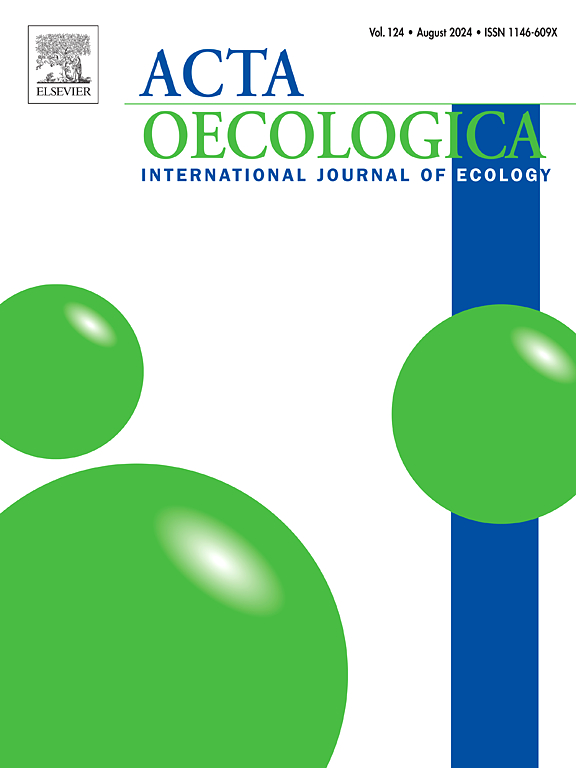低海拔植物的无脊椎草食损害在实验转移到高海拔后减少
IF 1.3
4区 环境科学与生态学
Q3 ECOLOGY
Acta Oecologica-International Journal of Ecology
Pub Date : 2025-06-07
DOI:10.1016/j.actao.2025.104099
引用次数: 0
摘要
为了应对气候变暖,许多植物和动物物种向更高的海拔迁移,导致新物种共存和新的植物-动物相互作用。这些变化会影响山地栖息地的物种多样性和群落组成。根据敌人释放假说,植物向新区域扩张可能会因为减少天敌(如食草动物)的伤害而变得容易。虽然已知这一机制促进了入侵物种的传播,但尚不清楚本地植物为应对不断上升的温度而向山上移动,是否也有助于在其当前海拔范围以上的地点减少食草性。在我们的研究中,我们通过实验验证了这一假设。本研究比较了6种盆栽低地植物在低地原生地和海拔上限以上地暴露于草食动物的伤害情况。作为对照,我们还测量了在整个海拔范围内自然生长的六种植物的草食损害。我们发现,低地植物迁移到高原后,食草性损害有所减少,而在两个海拔高度自然生长的物种的食草性损害没有差异。草食伤害的变化受叶片干物质含量、比叶面积的调节,株高也有一定程度的调节。我们的研究结果在海拔高度变化的背景下支持敌人释放假说。我们的结论是,减少食草动物的伤害可能有助于植物在当前的海拔上限上传播,以应对不断上升的温度。本文章由计算机程序翻译,如有差异,请以英文原文为准。

Invertebrate herbivore damage of lowland plant species decreases after an experimental shift to higher altitudes
Many plant and animal species move to higher altitudes in response to climate warming, leading to new species co-occurrences and novel plant-animal interactions. These shifts can impact species diversity and community composition in mountain habitats. According to the enemy release hypothesis, plant expansion into new areas may be facilitated by reduced damage from natural enemies, like herbivores. While this mechanism is known to facilitate the spread of invasive species, it is unclear whether the uphill movement of native plants, in response to rising temperatures, is also aided by reduced herbivory at sites above their current altitudinal range. In our study, we experimentally tested this hypothesis. We compared herbivore damage of six species of lowland plants grown in pots exposed to herbivores at their native sites in the lowland and at sites above their current upper altitudinal limit. As a control, we also measured herbivore damage of six plants growing naturally across the entire range of altitude. We found that lowland plants had reduced herbivore damage when they were moved to highland sites, while herbivore damage of species naturally growing at both altitudes did not differ. Changes of herbivore damage were modulated by leaf dry matter content, specific leaf area and to a lesser degree also by plant height. Our results support the enemy release hypothesis in the context of altitudinal range shifts. We conclude that reduced herbivore damage may help plants spread above their current upper altitudinal limit in response to rising temperatures.
求助全文
通过发布文献求助,成功后即可免费获取论文全文。
去求助
来源期刊
CiteScore
3.60
自引率
0.00%
发文量
57
审稿时长
>0 weeks
期刊介绍:
Acta Oecologica is venue for the publication of original research articles in ecology. We encourage studies in all areas of ecology, including ecosystem ecology, community ecology, population ecology, conservation ecology and evolutionary ecology. There is no bias with respect to taxon, biome or geographic area. Both theoretical and empirical papers are welcome, but combinations are particularly sought. Priority is given to papers based on explicitly stated hypotheses. Acta Oecologica also accepts review papers.

 求助内容:
求助内容: 应助结果提醒方式:
应助结果提醒方式:


